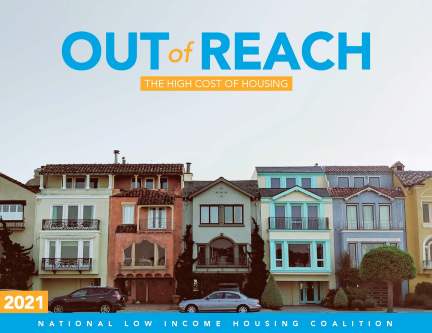The National Low Income Housing Coalition has released the 2021 version of its Out of Reach report which answers the question, “How much do you need to earn to afford a modest apartment?”
The report “is an estimate of the hourly wage full-time workers must earn to afford a rental home at HUD’s fair market rent without spending more than 30% of their incomes. Fair market rents are estimates of what a person moving today can expect to pay for a modestly priced rental home in a given area. The kind of home that can be rented for the fair market rent is in decent condition, but it is not luxury housing.
“The struggle to afford rental housing is not confined to minimum-wage workers. The average renter’s hourly wage of $18.78 is $6.12 less than the national two-bedroom Housing Wage and $1.62 less than the one-bedroom Housing Wage. As a result, the average renter must work 53 hours per week to afford a modest twobedroom apartment. Many single parents or caregivers find it difficult to work those hours.
“Wage growth has been slow for the lowest-wage workers for decades. Results from the Current Population Survey indicate that, between 1979 and 2019, inflation-adjusted hourly wages grew just 6.5% for the lowest-wage (at the 10th percentile) workers and 8.8% for median-wage workers. For Latino workers at the 10th percentile, inflation-adjusted hourly wages actually fell, as did the median hourly wages for Black and Latino men. In contrast, wages for the highest paid workers (at the 90th percentile) grew by 41.3%. Only in ten of the last 40 years did most workers see sustained increases in real wages, and in recent decades wages have been disconnected from increases in productivity. Between 1979 and 2018 productivity grew by nearly 70% while compensation for production and nonsupervisory workers grew by just 12%
“For many low-wage workers, employment is not sufficient to keep them out of poverty: the Bureau of Labor Statistics estimates that in 2018, seven million “working poor” individuals spent more than half the year in the labor force but fell below the official poverty level. Considering the criticisms that the official poverty measure undercounts the number of people experiencing what most would consider poverty, the actual number of “working poor” is likely even greater. There are racial disparities in who is likely to be working poor as well: 7.2% of Black workers in the labor force for at least 27 weeks per year were working poor, compared to 7% of Latino workers, 3.5% of white workers, and 2.3% of Asian workers. There are likely multiple reasons for these wage trends and the economic precarity of many workers in an otherwise rich country.
“Some argue that “job polarization”—a decline of jobs in the middle of the wage distribution and growth at the extreme—plays a role in explaining the prevalence of low wages. The industries in which people work might explain some trends: the share of jobs in manufacturing and production declined between 1979 and 2019, while the share of service-sector jobs, more likely to be low-wage, slightly increased. Even within industries, though, the types of jobs have changed, as technological changes have eliminated some jobs in the middle of the distribution. Changing job requirements may disadvantage low-wage workers and leave them with fewer options. The higher education wage premium increased significantly between 1979 and 2019. For workers without a college degree, median wages fell over this period. The continued prevalence of low-wage jobs is not a natural and unalterable outcome—public policy shapes workers’ prospects. Slow growth in the federal minimum wage likely indirectly affects all low-wage work. Lack of meaningful support for organized labor affects the bargaining power of low-wage workers. While private-sector unions historically helped boost wages, especially for lower-wage workers and for Black and Latino workers generally, the share of workers who were unionized fell from 27% in 1979 to 11.6% in 2019. By one estimate, wages would have been 7.9% higher in 2019 if not for the forty-year decline in unionization rates. Whatever the causes, low wages make it difficult for households to achieve long-term economic stability, to save for future needs or even just to pay the rent each month. The COVID-19 pandemic and economic crisis has made this already dire situation worse for many low-income workers.”
As you read these, keep in mind our community still gives away taxes for companies paying $13 an hour.
Here are Memphis’ disturbing data by zip code:
38126:
$15.38 – wages needed for two-bedroom housing
$13.08 – wages needed for one-bedroom housing
$680 – fair market rent for one-bedroom home
$800 – fair market rent for two-bedroom home
65.2% – poverty rate
$12,676 – median household income
50.1% – labor force penetration
24% – unemployment
96% – Black
38107:
$15.38 – wages needed for two-bedroom housing
$13.08 – wages needed for one-bedroom housing
$680 – fair market rent for one-bedroom home
$800 – fair market rent for two-bedroom home
31.7% – poverty rate
$29,192 – median household income
58.6% – labor force penetration
14% – unemployment
78.7% – Black
38106:
$15.38 – wages needed for two-bedroom housing
$13.08 – wages needed for one-bedroom housing
$680 – fair market rent for one-bedroom home
$800 – fair market rent for two-bedroom home
40.1% – poverty rate
$25,188 – median household income
52.7% – labor force penetration
22.2% – unemployment
95.9% – Black
38104:
$18.08 – wages needed for two-bedroom housing
$15.58 – wages needed for one-bedroom housing
$810 – fair market rent for one-bedroom home
$940 – fair market rent for two-bedroom home
20.52% – poverty rate
$41,696 – median household income
68.4% – labor force penetration
5% – unemployment
27.3% – Black
38105:
$15.96 – wages needed for two-bedroom housing
$13.65 – wages needed for one-bedroom housing
$710 – fair market rent for one-bedroom home
$830 – fair market rent for two-bedroom home
38.8% – poverty rate
$20,409 – median household income
59% – labor force penetration
15.1% – unemployment
78.2% – Black
38103:
$26.35 – wages needed for two-bedroom housing
$22.69 – wages needed for one-bedroom housing
$1180 – fair market rent for one-bedroom home
$1370 – fair market rent for two-bedroom home
14.1% – poverty rate
$71,850 – median household income
64.4% – labor force penetration
2.9% – unemployment
33.1% – Black
38115:
$18.27 – wages needed for two-bedroom housing
$15.77 – wages needed for one-bedroom housing
$820 – fair market rent for one-bedroom home
$950 – fair market rent for two-bedroom home
27.3% – poverty rate
$32,401 – median household income
74% – labor force penetration
7.5% – unemployment
84% – Black
38117:
$21.35 – wages needed for two-bedroom housing
$18.27 – wages needed for one-bedroom housing
$950 – fair market rent for one-bedroom home
$1110 – fair market rent for two-bedroom home
7.3% – poverty rate
$81.469 – median household income
66.3% – labor force penetration
3.4% – unemployment
9.5% – Black
38118:
$15.58 – wages needed for two-bedroom housing
$13.46 – wages needed for one-bedroom housing
$700 – fair market rent for one-bedroom home
$810 – fair market rent for two-bedroom home
33.2% – poverty rate
$35,355 – median household income
65.6% – labor force penetration
10.8% – unemployment
77.4% – Black
38138:
$26.35 – wages needed for two-bedroom housing
$22.69 – wages needed for one-bedroom housing
$1180 – fair market rent for one-bedroom home
$1370 – fair market rent for two-bedroom home
1.5% – poverty rate
$150,425 – median household income
62% – labor force penetration
5% – unemployment
1.1% – Black
38017:
$23.46 – wages needed for two-bedroom housing
$20.19 – wages needed for one-bedroom housing
$1050 – fair market rent for one-bedroom home
$1220 – fair market rent for two-bedroom home
3.8% – poverty rate
$110,873 – median household income
67.2% – labor force penetration
2.2% – unemployment
14.6% – Black
You can see more zip code profiles here.
**
Join us at the Smart City Memphis Facebook page for daily articles, reports, and commentaries that are relevant to Memphis.




